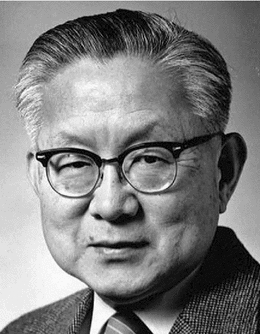

|

|
IN MEMORIAM
Chieh-Su Hsu
Professor of Applied Mechanics, Emeritus
UC Berkeley
1922—2014
Professor Chieh-Su (C.S.) Hsu, a renowned engineering scientist and inspiring teacher, who specialized in the areas of elasticity, vibrations, and nonlinear dynamics, passed away on July 25, 2014. Following his retirement in 1991, he continued to lead an active life in Cupertino, California, until the very end. Stricken by a heart attack on June 6, which led to medical complications, he died surrounded by his children, grandchildren, and great-grandchildren. He was laid to rest at Alta Mesa Memorial Park in Palo Alto, California.
Born on May 27, 1922, in Beijing, China, C.S. spent his early years in Suzhou, Jiangsu Province, with four other brothers and a sister. After the invasion of China by Japan in 1937, C.S. and his older brother evacuated to Chongqing. There, he attended high school and subsequently the Ordnance Military College (later known as National Institute [and Chongqing Institute] of Technology), graduating in 1945.
C.S. served in the army in 1945 and worked as an engineer at Shanghai Naval Dockyard and Engineering Works during 1946-47. Then came what he would later refer to as “the lucky break that changed my whole life”: he was one of only 60 students chosen in a nationwide competition for a scholarship to study abroad. He traveled to the U.S. to study engineering mechanics at Stanford University. He received his M.S. in 1948 and completed his Ph.D. in 1950. His research adviser was the famous elastician, J.N. Goodier.
At Stanford, C.S. met Helen Tse, an undergraduate in economics. From 1951 to 1955, C.S. was employed by IBM in Poughkeepsie, New York. In the meantime, Helen pursued a master’s degree in accounting at Columbia University. The couple married in New York City in 1953.
C.S. then returned to the academic life he loved so much, gaining an appointment in 1955 as an Associate Professor at the University of Toledo in Ohio. In 1958, he moved to the University of California, Berkeley, as an Associate Professor of Mechanical Engineering. In 1964, he was promoted to the rank of Professor. During the academic year 1969-70, he served as Chairman of the Division of Applied Mechanics. He became Professor Emeritus in 1991.
During his long academic career, Hsu made significant contributions to applied mechanics, particularly in the emerging area of nonlinear vibrations. He studied the stability and buckling of elastic bodies, including arches and shells. He became especially interested in phenomena associated with parametric excitation in discrete and continuous dynamical systems. He was the first to create a stability chart for dynamical systems with time lag. From the late 1970s onwards, Hsu studied point-to-point and cell-to-cell mappings of nonlinear dynamical systems. He introduced stability indices, devised algorithms for the analysis of global response and periodicity, and incorporated probability theory into cell-state concepts. He extended the technique of cell-to-cell mappings to problems in optimal control, bifurcation theory, random vibrations, and fuzzy dynamical systems. His book, Cell-to-Cell Mapping-A Method of Global Analysis of Nonlinear Systems (Springer-Verlag, 1987) stands as a noteworthy contribution to the field of nonlinear dynamics.
Professor Hsu advised over 25 Ph.D. students and advanced the education of countless others through his undergraduate and graduate classes. He was admired for his ability to convey difficult concepts with uncommon clarity, distilling each topic to its essence. He possessed a keen sense of the elegance of theoretical mechanics. Having a quiet personal warmth and charm, he was able to engage students in lively intellectual discussions. He led the dynamics group at Berkeley from the 1960s until his retirement.
Hsu contributed professionally at an international level. He was a member of the Scientific Advisory Board of the Alexander von Humboldt Foundation (1985-91). He served on the U.S. National Committee on Theoretical and Applied Mechanics (1985-89). From 1976 to 1982, he was Technical Editor of the Journal of Applied Mechanics (founded by Stephen Timoshenko, whom he greatly admired). He served on the editorial boards of several journals, including Acta Mechanica, the International Journal of Nonlinear Mechanics, and Bifurcation and Chaos in Applied Science and Engineering.
Hsu received many honors. He became a Fellow of the American Society of Mechanical Engineers (ASME) in 1977. He was elected to the National Academy of Engineering in 1988, and to Academia Sinica in China in 1990. For his contributions to vibration engineering, he was honored by the ASME both with the N. O. Myklestad Award (1995) and the J.P. den Hartog Award (2011).
C.S. was an avid hiker, visiting almost all of America’s national parks. He also enjoyed Tai Chi, bridge, Sudoku, and Mah Jong.
Chieh-Su Hsu was a kind and gentle soul. Taking care of people, being always respectful of others, acting with integrity, and promoting education, are values he practiced throughout his life. His love and devotion to his family was unbounded. He is dearly missed by his sister Hou Su; his wife Helen; his 2 children and their spouses: Ray (Donna), Kathy (Greg); his 4 grandchildren: Aaron (Johanna) Hsu, Nick Hsu, Nathan and Stephan Burroughs; and his 2 great-grandchildren Mikaela and Saraqael Hsu.
At an extraordinary institution like Berkeley, C.S. Hsu felt free to pursue the research that captured his imagination. His work was both innovative and scholarly. Through his teaching and congenial interactions, he left a lasting impression on students and faculty alike. He exemplifies a life full and well-lived.
Fai Ma
James Casey
George Leitmann
Jian-Qiao Sun (UC Merced)